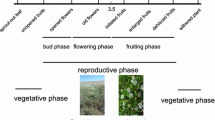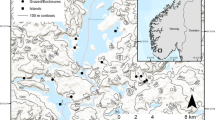Abstract
Plants of low stature may benefit from the presence of large herbivores through removal of tall competitive neighbours and increased light availability. Accordingly, removal of grazers has been predicted to disfavour small species. In addition to this indirect beneficial effect, the population dynamics of plants is strongly influenced by variation in external conditions such as temperature and precipitation. However, few studies have examined the interaction between large herbivores and inter-annual variation in climate for the population dynamics of small plant species not preferred by herbivores. We studied three populations of the perennial herb Viola biflora exposed to different sheep densities (high, low and zero) for 6 years in a field experiment. Plants were also impacted by invertebrate and small vertebrate herbivores (rodents). Rates of growth were marginally higher at high sheep densities, and during warm summers both survival and growth were higher when sheep were present. Thus, while the height of tall herbs was positively related to July temperature, it was less so in the treatments with sheep, suggesting that sheep reduce the negative effects of interspecific competition for this small herb. Life table response experiment analyses revealed that the population growth rate (λ) was slightly lower in the absence of sheep, but between-year variation in λ was larger than variation among sheep density treatments. λ was negatively related to July temperature, with an additional negative effect of vertebrate grazing frequency (sheep or rodent grazing). The evidence from this 6-year study suggests that the population dynamics of Viola biflora is determined by a complex interplay between climate and grazing by both large and small herbivores.






Similar content being viewed by others
References
Andersen AN (1989) How important is seed predation to recruitment in stable populations of long-lived perennials? Oecologia 81:310–315
Arft AM, Walker MD, Gurevitch J, Alatalo JM, Bret-Harte MS, Dale M, Diemer M, Gugerli F, Henry GHR, Jones MH, Hollister RD, Jónsdóttir IS, Laine K, Lévesque E, Marion GM, Molau U, Mølgaard P, Nordenhäll U, Raszhivin V, Robinson CH, Starr G, Stenström A, Stenström M, Totland Ø, Turner PL, Walker LJ, Webber PJ, Welker MJ, Wookey PA (1999) Responses of tundra plants to experimental warming: meta-analysis of the Interational Tundra Experiment. Ecol Monogr 69:491–511
Augustine DJ, McNaughton SJ (1998) Ungulate effects on the functional species composition of plant communities: herbivore selectivity and plant tolerance. J Wild Manage 62:1165–1183
Austrheim G, Mysterud A, Pedersen B, Økland RH, Hassel K, Evju M (2008) Large scale experimental effects of three levels of sheep densities on an alpine ecosystem. Oikos 117:837–846
Bastrenta B, Lebreton J-D, Thompson JD (1995) Predicting demographic change in response to herbivory—a model of the effects of grazing and annual variation on the population dynamics of Anthyllis vulneraria. J Ecol 83:603–611
Bates D, Maechler M (2009) lme4: linear mixed-effects models using S4 classes. R package version 0.999375-32. http://CRAN.R-project.org/package=lme4
Brooker R, van der Wal R (2003) Can soil temperature direct the composition of High Arctic plant communities? J Veg Sci 14:535–542
Brys R, Jacquemyn H, Endels P, De Blust G, Hermy M (2004) The effects of grassland management on plant performance and demography in the perennial herb Primula veris. J Appl Ecol 41:1080–1091
Bullock JM, Clear Hill B, Silvertown J (1994) Demography of Cirsium vulgare in a grazing experiment. J Ecol 82:101–111
Callaghan TV, Carlsson BA, Tyler NJC (1989) Historical records of climate-related growth in Cassiope tetragona from the Arctic. J Ecol 77:823–837
Carlsson BÅ, Callaghan TV (1994) Impact of climate change factors on the clonal sedge Carex bigelowii: implications for population growth and vegetative spread. Ecography 17:321–330
Carson WP, Peterson CJ (1990) The role of litter in an old-field community: impact of litter quantity in different seasons on plant species richness and abundance. Oecologia 85:8–13
Caswell H (2001) Matrix population models: construction, analysis and interpretation, 2nd edn. Sinauer, Sunderland
Chambers JC (1995) Relationship between seed fates and seedling establishment in an alpine ecosystem. Ecology 76:2124–2133
Crawley MJ (2003) Statistical computing. An introduction to data analysis using S-Plus. Wiley, Chichester
Díaz S, Lavorel S, McIntyre S, Falczuk V, Casanoves F, Milchunas DG, Skarpe C, Rusch G, Sternberg M, Noy-Meir I, Landsberg J, Zhang W, Clark H, Campbell BD (2007) Plant trait responses to grazing—a global synthesis. Glob Chang Biol 13:313–341
Doak DF (1992) Life-time impacts of herbivory for a perennial plant. Ecology 73:2086–2099
Dunnett NP, Grime JP (1999) Competition as an amplifier of short-term vegetation response to climate: an experimental test. Funct Ecol 13:388–395
Ehrlén J, Syrjänen K, Leimu R, García MB, Lehtilä K (2005) Land use and population growth of Primula veris: an experimental demographic approach. J Appl Ecol 42:317–326
Eriksson O (1996) Regional dynamics of plants: a review of evidence for remnant, source-sink and metapopulations. Oikos 77:248–258
Eskelinen A (2008) Herbivore and neighbour effects on tundra plants depend on species identity, nutrient availability and local environmental conditions. J Ecol 96:155–165
Eskelinen A, Oksanen J (2006) Changes in the abundance, composition and species richness of mountain vegetation in relation to summer grazing by reindeer. J Veg Sci 17:245–254
Evju M (2009) Sheep grazing and dynamics of alpine plants in a landscape-scale experiment. Ph.D. thesis. University of Oslo, Oslo
Evju M, Mysterud A, Austrheim G, Økland RH (2006) Selecting herb species and traits as indicators of sheep grazing pressure in a Norwegian alpine habitat. Écoscience 13:459–468
Evju M, Austrheim G, Halvorsen R, Mysterud A (2009) Grazing responses in herbs in relation to herbivore selectivity and plant traits in an alpine ecosystem. Oecologia 161:77–85
Forbis TA (2003) Seedling demography in an alpine environment. Am J Bot 90:1197–1206
Hobbs NT (1996) Modification of ecosystems by ungulates. J Wild Manage 60:695–713
Horvitz C, Schemske DW, Caswell H (1997) The relative ‘importance’ of life-history stages to population growth: prospective and retrospective analyses. In: Tuljapurkar S, Caswell H (eds) Structured-population models in marine terrestrial and freshwater systems. Chapman & Hall, New York, pp 247–272
Hunt LP (2001) Low seed availability may limit recruitment in grazed Atriplex vesicaria and contribute to its local extinction. Plant Ecol 157:53–67
Klanderud K (2008) Species-specific responses of an alpine plant community under simulated environmental change. J Veg Sci 19:363–372
Knight TM (2004) The effect of herbivory and pollen limitation on a declining population of Trillium grandiflorum. Ecol Appl 14:915–928
Lacey EP (1986) Onset of reproduction in plants: size-versus age-dependency. Trends Ecol Evol 1:72–75
Lennartsson T, Oostermeijer JGB (2001) Demographic variation and population viability in Gentianella campestris: effects of grassland management and environmental stochasticity. J Ecol 89:451–463
Lesica P, Steele BM (1994) Prolonged dormancy in vascular plants and implications for monitoring studies. Nat Areas J 14:209–212
Lid J, Lid DT (2005) Norsk flora, 7th edn. Det Norske Samlaget, Oslo
Mobæk R, Mysterud A, Loe LE, Holand Ø, Austrheim G (2009) Density dependence and temporal variability in habitat selection by a large herbivore: an experimental approach. Oikos 118:209–218
Moen J, Oksanen L (1998) Long-term exclusion of folivorous mammals in two arctic-alpine plant communities: a test of the hypothesis of exploitation ecosystems. Oikos 82:333–346
Molau U, Larsson EL (2000) Seed rain and seed bank along an alpine altitudinal gradient in Swedish lapland. Can J Bot 78:728–747
Mulder CPH (1999) Vertebrate herbivores and plants in the Arctic and Subarctic: effects on individuals, populations, communities and ecosystems. Perspect Plant Ecol 2:29–55
Økland RH (1997) Population biology of the clonal moss Hylocomium splendens in Norwegian boreal spruce forests. III. Six-year demographic variation in two areas. Lindbergia 22:49–68
Økland RH, Eilertsen O (1996) Dynamics of understorey vegetation in an old-growth boreal coniferous forest, 1988–1993. J Veg Sci 7:747–762
Økland RH, Økland T, Rydgren K (2001) Vegetation-environment relationships of boreal spruce swamp forests in Østmarka Nature Reserve, SE Norway. Sommerfeltia 29:1–190
Olofsson J (2006) Short- and long-term effects of changes in reindeer grazing pressure on tundra heath vegetation. J Ecol 94:431–440
Olofsson J, Moen J, Oksanen L (2002) Effects of herbivory on competition intensity in two arctic-alpine tundra communities with different productivity. Oikos 96:265–272
Olofsson J, Hulme PE, Oksanen L, Suominen O (2004) Importance of large and small mammalian herbivores for the plant community structure in the forest tundra ecotone. Oikos 106:324–334
Olofsson J, Oksanen L, Callaghan T, Hulme PE, Oksanen T, Suominen O (2009) Herbivores inhibit climate-driven shrub expansion in the tundra. Glob Chang Biol 15:2681–2693
Piqueras J (1999) Herbivory and ramet performance in the clonal herb Trientalis europeaea L. J Ecol 87:450–460
Post E, Pedersen C (2008) Opposing plant community responses to warming with and without herbivores. PNAS 105:12353–12358
R Development Core Team (2009) R: a language and environment for statistical computing. R Foundation for Statistical Computing, Vienna
Ritchie ME, Olff H (1999) Herbivore diversity and plant dynamics: compensatory and additive effects. In: Olff H, Brown VK, Drent RH (eds) Herbivores: between plants and predators. Blackwell, Oxford, pp 175–204
Rydgren K, Økland RH, Picó FX, de Kroon H (2007) Moss species benefits from breakdown of cyclic rodent dynamics in boreal forests. Ecology 88:2320–2329
Silvertown J, Franco M, Pisanty I, Mendoza A (1993) Comparative plant ecology—relative importance of life-cycle components to the finite rate of increase in woody and herbaceous perennials. J Ecol 81:465–476
Steen H, Mysterud A, Austrheim G (2005) Sheep grazing and rodent populations: evidence of negative interactions from a landscape scale experiment. Oecologia 143:357–364
Stubben C, Milligan B, Nantel P (2008) Popbio: construction and analysis of matrix population models. R package version 1.1.8
Svensson BM, Carlsson BÅ, Karlsson PS, Nordell KO (1993) Comparative long-term demography of three species of Pinguicula. J Ecol 81:635–645
Tansley AG, Adamson RS (1925) Studies of the vegetation of the English chalk. III. The chalk grasslands of the Hampshire-Sussex border. J Ecol 13:177–223
Thompson K, Bakker JP, Bekker RM (1997) The soil seed banks of north west Europe: methodology, density and longevity. Cambridge University Press, Cambridge
Tveito OE, Bjørdal I, Skjelvåg AE, Aune B (2005) A GIS-based agro-ecological decision system based on gridded climatology. Met Appl 12:57–68
Vandvik V (2002) Pattern and process in Norwegian upland grasslands: an integrated ecological approach. Dr. Scient. thesis. University of Bergen, Bergen
Welling P, Laine K (2002) Regeneration by seeds in alpine meadow and heath vegetation in sub-arctic Finland. J Veg Sci 13:217–226
Welling P, Tolvanen A, Laine K (2004) The alpine soil seed bank in relation to field seedlings and standing vegetation in subarctic Finland. Arct Antarct Alp Res 36:229–238
Acknowledgments
This study was funded by the Research Council of Norway (project 153601/432 and 134361/720). We are grateful to Synnøve Lindgren for help with field work in 2003, to Dagrun Vikhamar Schuler at the Norwegian Meteorological Institute for providing interpolated climate data, and to Miguel Franco and two anonymous referees for valuable comments that have greatly improved the manuscript. The sheep grazing experiment complies with the laws of Norway.
Author information
Authors and Affiliations
Corresponding author
Additional information
Communicated by Miguel Franco.
Electronic supplementary material
Below is the link to the electronic supplementary material.
Rights and permissions
About this article
Cite this article
Evju, M., Halvorsen, R., Rydgren, K. et al. Interactions between local climate and grazing determine the population dynamics of the small herb Viola biflora . Oecologia 163, 921–933 (2010). https://doi.org/10.1007/s00442-010-1637-x
Received:
Accepted:
Published:
Issue Date:
DOI: https://doi.org/10.1007/s00442-010-1637-x




